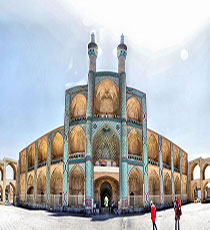Amir Chakhmaq Complex
One of the most significant historical and ancient complexes in Yazd city which is located in the middle of the old architectural context is Amir Chakhmaq complex. This complex is surrounded by various building with special architecture style, such as the mosque, Ab-Anbar, Tekye, tomb, and Bazaar. You can enjoy sightseeing and shopping at the same time.

Description
This Square is a prominent structure in Yazd, Iran, noted for its symmetrical sunken alcoves. It also contains a caravanserai, a tekyeh, a bathhouse, a cold water well, and a confectionery. At night, the building of the complex is lit up after twilight hours after sun set with orange lighting in the arched alcoves which makes it a spectacle.
Many parts deteriorated until the 18th century in the Safavid era at Amir Chakhmaq Complex, when Bahador Khan Shams Yousef Meibodi renovated some parts and reconstructed the caravanserai in the same location. This complex again encountered erosion until the late 19th century when, according to Vahdat Zad, the Tekyeh was built by Abu-al-Qasim Rashti at the entrance of the bazaar. Most of the changes in this complex were implemented during the modernization period of Reza Shah. By completing Pahlavi Street in 1935, the northern part of the square, which connected it with the Bazaar, was demolished.
History
The Square, according to Dr. Vahdat Zad, an architectural historian who has worked extensively on the spatial aspects of the square, was built in the 15th century by Jalal-al-Din Amir Chakhmaq, the governor of Yazd in the Timurid era. This square was established on the north side of an important mosque called the Old Mosque.
According to Vahdat Zad, “the mosque was also founded between 1418 and 1438. The same year the mosque was inaugurated, Haj Qanbar Jahanshahi, who was the subsequent governor, constructed a bazaar and caravanserai at the sides of the square”.
Amir Chakhmaq Tekyeh
The complex includes the three-storey tekyeh which used to commemorate the death of Hussein-ebn-e-Ali (son of Ali ibn Abi Talib, the third Shia Imam). In the corner of the tekyeh, there is a nakhl, described as a "strong, wooden object with very large metal fixtures and studs". It was venerated during the Shiite commemoration festival of Ashura.
Amir Chakhmaq mosque
On the southern side of this square, the mosque was built in 841 AH. The beauty and magnitude of this mosque is so much that is the second most important mosque in Yazd. It has two entrances, one of them is from the adjacent alley and the other one is from the courtyard of Seti Fatima's Tomb; thus, there is a common courtyard between the tomb and the mosque. The dome of the mosque is curved and cracked, covered with green tiles and surrounded by an inscription in Kofi handwriting.